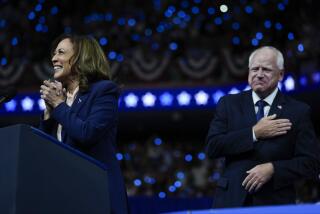Running Mates: an Overvalued Commodity
- Share via
The Democrats’ presidential nominee in 1904, Alton B. Parker, a conservative New York judge, chose an 80-year-old millionaire, Henry G. Davis, as his running mate because it was hoped that he would bankroll the party’s underdog campaign. Democrat Adlai Stevenson in 1956 cared so little about the vice presidential slot that he turned the decision over to the convention. The calculations of today’s presidential standard-bearers tend to be somewhat more systematic, but their decisions can still leave seasoned political observers shaking their heads in puzzlement.
The most common standard for a running mate has been that the person in the second spot balance the ticket. Balance used to mean strict geographical equilibrium, such as the combination of a Virginia President and a New York vice president. Toward the end of the 19th Century, ideology became an element in ticket-balancing, such as in the decision by old guard Republican William McKinley to take on as a running mate progressive reformer Theodore Roosevelt.
In recent years, more complex formulas for balance have become common. In what experts consider the only modern example of an election-deciding vice-presidential selection, Massachusetts Sen. John F. Kennedy chose Texas Sen. Lyndon B. Johnson. Johnson was perceived as a conservative, had a strong following in the South, was the majority leader of the Senate--and he was a defeated rival for the nomination; his selection would promote party unity.
Kennedy’s choice of Johnson stands out as a glowing exception to a record that is almost barren of evidence that the No. 2 person exerts much of a positive influence on the outcome of the election. Running mates, in fact, seem to have most of their influence on the down side.
Standard-bearers seem habitually to be embarrassed in one way or other by their running mates. Dwight D. Eisenhower, in 1952, was on the verge of dumping California Sen. Richard M. Nixon over a secret fund set up for him by businessmen. Only Nixon’s now-famous “Checkers” speech on television saved the day when viewers registered their support for him.
Yet the record shows that vice presidents more often than not prove irrelevant to victory. In 1968, Maryland Gov. Spiro T. Agnew, who was chosen by presidential nominee Nixon, ironically, as a sop to liberals, disgraced himself by making ethnic slurs. Agnew’s opposite number, Maine Sen. Edmund S. Muskie, was, in contrast, an effective running mate for Hubert H. Humphrey. But the Humphrey ticket, burdened with the legacy of an escalated Vietnam War, still lost to Nixon--even with the knavish Agnew in the second spot.
The Agnew nomination, the embarrassing rejection by George S. McGovern in 1972 of Sen. Thomas Eagleton after revelations that he had suppressed evidence of a nervous breakdown, and the furor in 1984 over Rep. Geraldine A. Ferraro’s family finances--all are examples of the hot water into which presidential nominees can be plunged by prospective running mates who are either not forthright or are not thoroughly examined before they are chosen.
As Michael S. Dukakis and George Bush conduct their surveys and interviews, they enjoy one advantage over some nominees who blundered in their selection of running mates. Both men wrapped up their nominations early. They have the time to develop a complete inventory of likely prospects and to delve deeply into their backgrounds.
As always, region and ideology will be influential factors, and if the two can be combined with a congressional insider, it might turn out to be one of those few examples of a running mate being a decisive element. For Bush, it might be someone like Mississippi Sen. Thad Cochran, who combines impeccable conservative credentials with a likable, non-dogmatic manner. The Westerner who would give Bush a regional and ideological complement, California Gov. George Deukmejian, has problems with a state tax shortfall that has pretty much taken him out of consideration despite the lure of the state’s 47 electoral votes. Colorado Sen. William L. Armstrong also has many of the characteristics that Bush will need. Kansas Sen. Robert Dole would probably represent for Bush some of the same political advantages that L.B.J. represented for J.F.K.
For Dukakis, with no obvious Californian to tap, the South and border states would seem to offer the most attractive prospect for a running mate to provide both regional and ideological balance to the ticket. Tennessee Sen. Albert Gore ran well in the Southern rim on Super Tuesday and is seen as more hawkish on defense than Dukakis. Gore is also a lively and vigorous campaigner, in contrast to the somewhat bookish Georgia Sen. Sam Nunn. Rep. Richard Gephardt seems to have many of the same qualities as Gore, and the very elusiveness of his philosophy that proved a problem in the primaries might be a real benefit in November. Less understandable is the recent boom for Ohio Sen. John Glenn, the early favorite in 1984 who proved an inept and uninspiring campaigner, for all his heroic characteristics.
In the last analysis, it may be personal compatibility more than any political trait that will be decisive for Bush and Dukakis. It was to establish whether the chemistry was going to work that caused Jimmy Carter to invite a succession of hopefuls and their wives to Plains, Ga., in 1976. Carter and his ultimate choice, Sen. Walter F. Mondale, turned out to be a strong campaign team. Getting a feel for the person with whom you’ll be campaigning and governing is an essential ingredient for any contemporary presidential nominee.
More to Read
Get the L.A. Times Politics newsletter
Deeply reported insights into legislation, politics and policy from Sacramento, Washington and beyond. In your inbox twice per week.
You may occasionally receive promotional content from the Los Angeles Times.










